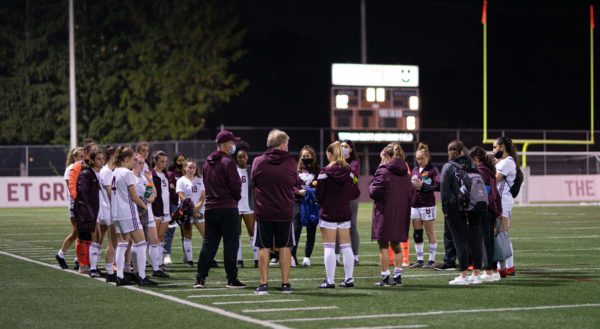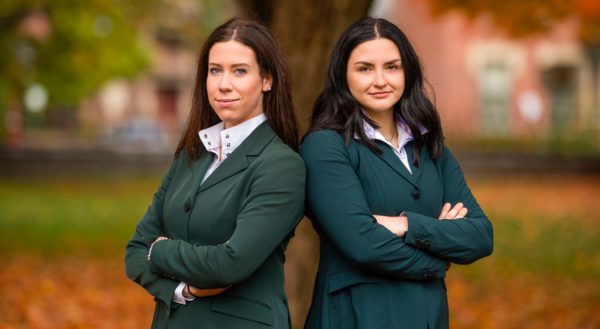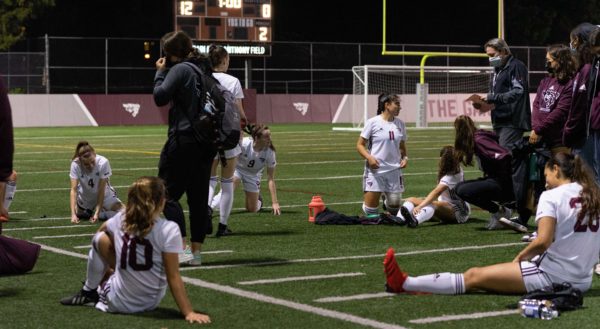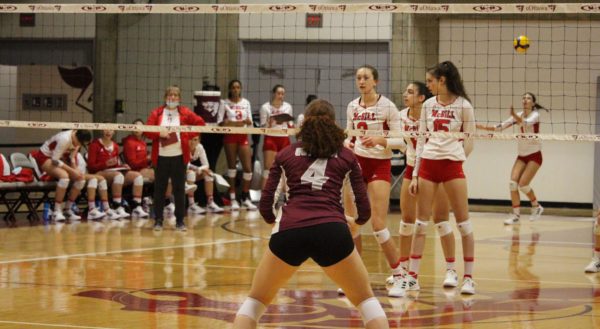Beyond binaries
On Jan. 9, 2022, an eight-year-old-girl named Hannah G. wrote a strongly worded letter to Tim Hortons expressing her displeasure with the state of equal gender representation in hockey.
When Hannah purchased a pack of Tim Hortons hockey cards that claimed to include women hockey players, she was more than disappointed to find that only five out of the forty-five of them featured women. Fed up, the young athlete-turned-activist took matters into her own hands and publicly urged Tim Hortons to rectify this disparity, emphasizing that “this problem should be fixed immediately.”
However, this problem is not unique to Tim Hortons’ hockey cards, nor is it an issue of hockey alone. It’s an issue all too prevalent in sports of all levels: blatant inequity. Athletes, commentators, coaches, agents, and professionals in athletics are constantly victim to rampant disparities in respect, opportunities, and representation on the basis of gender. Like everything else that permeates our lives, sports, too, are not created equal.
For the game to be worth playing, watching, and supporting, it must first be fair. It must, thus, prioritize equity.
A question of equity
As the interim head coach and program manager of women’s basketball at the University of Ottawa, a full-time coach of four years, and a long-time athlete, Rose-Anne Joly prioritizes equity in sports.

Even so, she recognizes that this equity is not always afforded. In fact, Joly’s athletic journey is exemplary of the fundamental importance of equal opportunities and representation in sports.
“Equity is really about offering the same opportunities, whether it’s a male sport or a female sport. [This] is not always the case, whether it’s salaries, or gym availability, disability, visibility on social media or on TV. I’m talking about all sports — it’s not just basketball,” stated Joly in an interview.
“I never had a female head coach […] funny enough, right now I’m a full-time coach. I’ve been a full-time coach for four years. But I didn’t know that—until I became a full-time coach—that I could become one because I am a woman,” explained Joly.
Melina De Iulio, a fourth-year U of O student studying human kinetics, has also experienced the effects of the lack of gender parity in sports. Though they are currently a valued player of the Gee-Gees women’s basketball team, it was not without a great deal of effort that they even first began playing basketball.
“When I started playing [basketball], I had to go to other cities, and it was crazy to me because basketball in Burlington, [ON] for guys is such a huge thing,” shared De Iulio in an interview.
The stories of Joly and De Iulio are reflective of the experiences of so many other women in sports, as a 2019 study found that annually in the United States, boys benefit from 1.13 million more sports opportunities than girls.

Tragically, even inequalities are not created equal. Though the state of gender equality in sports has ameliorated throughout the years, like most revolutions, it has functioned in a top-down method. Trickle-down revolutions tend to reach marginalized communities last, as in the case of the right to vote that left Indigenous people without the right to vote until 1960.
To this same effect, impoverished girls are still less likely to have access to sports opportunities, transgender individuals continue to face exclusion in sports at all levels, and there is consistently disproportionately less participation of BIPOC girls in sports in North America. Such is the way inequalities exacerbate existing inequalities.
Moreover, equal opportunity is more than just the existence of a girls’ program. That program must have an equal investment of time, money, and resources, as well.
“Finding ice time for girls’ hockey, or finding the opportunity to go tournaments and rent busses and the many little things you didn’t get access to,” explained Caitlin Huss, co-captain of the U of O equestrian team.
Sure, equal investment is a large feat that many critique as unattainable. However, I believe that this is a limited view. It is important to remember what progress we have made thus far seemed completely implausible less than fifty years ago. Consider the 1972 Title IX Education Amendment in the United States, for example.
Title IX is a pivotal piece of gender equity legislation that mandated the eradication of sex discrimination in federally funded education programs and, in turn, broadened opportunities for women and girls in atheltics. The proof of such legislation is in the numbers. In 1972, the United States only boasted of 300,000 women and girls playing college and high school sports, with female athletes receiving 2 per cent of college athletic budgets, and little to no athletic scholarships for women. 40 years after Title IX’s passage, the number of girls participating in high school sports has surpassed 3 million, and over 190,000 women were competing in post-secondary level sports, an increase of ten and six times respectively.
So, despite the effort it takes to create equitably funded athletic programs for women and girls, it is not impossible. Rather, it’s integral. It is paramount to have the audacity of hope in tow with the power of legislation as we continue to set precedents in athletic equality.
In the same vein, the inequity experienced by young girls is only heightened at the professional level.
“If you think about it, our Canadian women’s soccer team won a gold medal at the Olympics this summer and every single one of them plays their professional club soccer outside of Canada because we do not have a league for them to play in,” emphasized Bridie Hamilton, co-captain of the equestrian team.

Coach Joly brought up the important topic of iniquitous hiring, with the example of Rachel Balkovec, who, despite her “loaded resume,” was not hired until she modified her resume to hide her female identity. Conversely, Joly emphasized that it is important that hiring and representation not be performative.
“I personally know that I’ve been given opportunities in the past just based on what I look like and it’s very frustrating to know because then you’re put in a position where you’re not used because they don’t care about what knowledge you have or the experience you have. They only care about what you look like,” shared Joly.
“To me, it just made me work even harder. My life philosophy is really not to prove people wrong. I don’t care what other people think. I’m here to do my job and I’m here to do what I need to do. I’m so tired of hearing all the first women to be hired for this position, but the thing is, it’s not just about hiring women. It’s about hiring women and making sure that the environment they’re going to work in is fair, that she’s not going to be harassed, it’s going to be a positive environment, it’s going to be a safe environment,” concluded Joly.
Equal opportunity is equal representation
The issue of the unequal representation of women in media is not only in the case of streaming, but in the way in which women’s sports are marketed. Though women’s sports underrepresentation apologists chalk up the disparity in streaming to a mere lack of demand, only “4 per cent of the total commercial investment in sport goes into women’s sport, despite a 2018 Nielsen report revealing that 84 per cent of general sports fans have an interest in women’s sports,” despite the fact that women make up 40 per cent of sportspeople.
“When you provide it to people, they will watch it,” concurred De Iulio.
It’s true. Over and over, people negate the issue of representation as a mere issue of a lack of demand but in 2015, the Women’s World Cup soccer final was the most-watched soccer match, regardless of gender, in the US, with nearly 25.4 million viewers.

“Yes, it’s important for girls to see that, but it’s also so important for a young boy to open that and see that there are just as many girls as boys in that pack of cards,” stated Hamilton, articulating the importance of equal representation.
An issue of respect
The inequities in women’s sports derive from a lack of respect that is too often intertwined with women’s professions, hobbies, and interests. It is misogyny that depreciates female-dominated fields and interests, something we see at the juvenile level.
Why else are boy bands, the colour pink, and sororities written off as silly, feminine interests? Such is the case of the wage-gap, and the unpaid domestic labour conducted by women that is undervalued because it is regarded as feminine. This disrespect expands to include female-dominated sports, like equine sports. However, the equestrian team co-captains are adamant that, not only is horseback riding a sport that requires a great deal of skill and athleticism, but it also acts as a model for equality in athletics.
“A really unique thing about riding […] is that it’s one of two Olympic sports where men and women compete directly against each other in the world. At no point in riding at any age are you separated based on your gender. You compete directly against and with them,” emphasized Hamilton.

Though there is much dispute regarding the value of sex and gender segregation in competitive sports, with no finite conclusion drawn by scholars or athletes alike, it is commendable that the skills of equine athletes are reportedly not undervalued on the basis of their gender. The sad truth is that the same cannot be said for all sports.
“The general perception of riding is that we’re just rich, pretty, girls that just kind of sit there. On our team, we work hard not to feed into that because we’re trying to change that,” continued Hamilton.
Such is the issue of binaries in the perception of women. A woman is smart or pretty or strong; never all. Why can’t you be pretty and be an excellent athlete? It is emblematic of the hyper-sexualization and fixation on women’s physique in sports. We saw this when Serena Williams performed exceptionally at the 2018 French Open, but the media chose to fixate on her catsuit. We saw it when Norway’s beach handball team was fined for dressing modestly, as per their comfort. Huss and Hamilton saw this when they received sexual comments regarding their sport when they were as young as fourteen.

Overall, it’s apparent that Hannah G.’s issue with the lack of gender equity in Tim Horton’s hockey cards did not exist in a vacuum. It’s in every part of athletics, just as much as it is in every part of life.
“It’s tough because we’re nice. We’re female. We’re gentle and we’re all these characteristics that men like and we don’t push and we can’t be too emotional. But when we fight it, then it becomes annoying. We’re bipolar, I’ve been told before, and I’m aggressive, and I’m too this and I’m too that. I’m fighting for my rights and if I’m put in a position that isn’t a positive environment, then obviously I’m going to say something. I didn’t use to, but now I’m tired of it,” shared Joly.
Now is not the time to be nice. It’s time to demand change, just like Hannah G. Though her letter went viral, its presence came and went. The movement it fostered, though, ought to stay. Sure, there’s been growth in equity in athletics, but it’s not time to throw in the towel yet when it comes to demanding change. It’s time to move beyond celebrating firsts and make equity the standard.
“When the Olympics come on, or there’s a big issue, like the playing cards, people all of a sudden want to pay a lot of attention. And that’s great, but I think that it’s equally important to pay attention when nothing exciting is happening. That’s actually when the impact means the most and that’s why the most important thing people can do is watch them play whenever,” concluded Hamilton.




